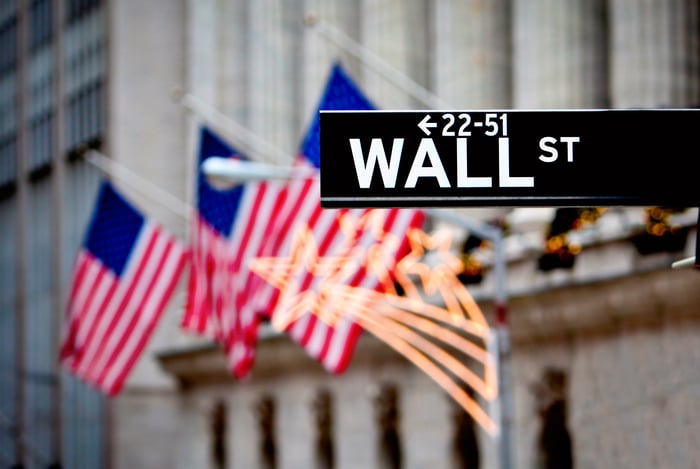The benchmark S&P 500 index has delivered a return of about 8.5% so far in 2023. That's well below its 13.7% average annual return during the past decade.
Still, investors might be surprised to know the S&P 500 has been driven higher this year by a specific group of stocks dubbed the "Magnificent Seven." The term was coined by Bank of America analyst Michael Hartnett to describe seven of America's top technology giants, which currently make up almost 28% of the index's value.
The other 493 companies in the S&P 500 -- which make up the remaining 72% of its value -- are actually weighing it down in 2023. Here's how different the stock market's performance would be this year without the Magnificent Seven.

Image source: Getty Images.
Unpacking the Magnificent Seven stocks
This isn't the first time Wall Street has grouped a set of powerhouse stocks together. In 2017, CNBC personality Jim Cramer used the FAANG acronym to describe five of the top performing stocks at the time:
- Facebook, which now trades as Meta Platforms (META -2.81%)
- Apple (AAPL 3.00%)
- Amazon (AMZN 0.41%)
- Netflix
- Google, which now trades under its parent company, Alphabet (GOOGL -3.23%) (GOOG -3.17%)
Identifying the top performing stocks in the market and lumping them together can give investors a North Star to guide them on their investing journey. The Magnificent Seven might be the best example of that so far because, as I'll explain later, its heavy weighting in the closely watched S&P 500 index makes the group incredibly hard to ignore.
Below is a list of the Magnificent Seven stocks and their performance so far in 2023. Remember, the S&P 500 is up just 8.5% over the same period:
|
Stock |
2023 Return |
|---|---|
|
Apple |
31% |
|
Alphabet |
41% |
|
Microsoft (MSFT -1.37%) |
41% |
|
Amazon |
58% |
|
Tesla (TSLA 15.20%) |
63% |
|
Meta Platforms |
150% |
|
Nvidia (NVDA -0.30%) |
179% |
Data source: Yahoo Finance. Returns as of Oct. 31
The Magnificent Seven is outperforming for several reasons
Artificial intelligence (AI) has been the dominant theme across the stock market this year, and each of the companies in the Magnificent Seven is developing the technology.
Semiconductor giant Nvidia has an estimated 90% share in the market for data center chips capable of handling AI workloads. Microsoft, Amazon, and Alphabet are racing to get their hands on that hardware to upgrade their data center infrastructure. Their cloud computing customers want that processing power to develop their own AI applications to boost productivity.
Apple has designed its own chips capable of handling workloads on-device in its new iPhone 15 Pro smartphone lineup. Plus, the company is reportedly developing its own large language model to power a new chatbot, and to give its Siri voice assistant new capabilities next year.
Tesla and Meta Platforms are using AI to enhance their existing products. Tesla has developed some of the most advanced autonomous self-driving software in the world using the technology, and Meta is integrating it into its Facebook and Instagram social media platforms in more ways than one.
Investors are eyeing the long-term potential of AI, which -- depending on the Wall Street estimate you rely upon -- could add anywhere from $7 trillion to $200 trillion to the global economy by 2030. Therefore, it makes sense they're piling into the Magnificent Seven stocks.
Here's where the S&P 500 would be in 2023 without the Magnificent Seven
The companies in the S&P 500 index are weighted by their market capitalization (valuation). Larger companies have a higher weighting and, therefore, have a greater influence on the index's price.
The Magnificent Seven companies are worth a combined $10.4 trillion, making up 27.7% of the S&P 500's total $37.7 trillion in total market cap. So the group can really sway the index -- and I'll show you by just how much.
To remove the influence of the Magnificent Seven, investors can look at the S&P 500 Equal Weight Index. It features exactly the same companies as the S&P 500, except they are each given an equal representation in this index no matter their market capitalization. Here's the difference in performance between the two indexes this year:
|
Index |
2023 Return |
|---|---|
|
S&P 500 |
8.5% |
|
S&P 500 Equal Weight Index |
(4%) |
Data source: S&P Global. Returns as of Oct. 31
That's right. While the S&P 500 index has gained 8.5% this year, the Equal Weight Index is down 4%. That's a 12.5% swing, driven largely by the substantial outperformance of the Magnificent Seven stocks I highlighted earlier.
But that influence cuts both ways. If those tech giants suffer a substantial decline in value, it could drag down the entire S&P 500. In any case, they each have dominant, established businesses, and their focus on new technologies like AI should buoy their growth prospects -- and the S&P 500 -- for many years to come.





